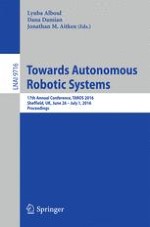2016 | Buch
Towards Autonomous Robotic Systems
17th Annual Conference, TAROS 2016, Sheffield, UK, June 26--July 1, 2016, Proceedings
herausgegeben von: Lyuba Alboul, Dana Damian, Jonathan M. Aitken
Verlag: Springer International Publishing
Buchreihe : Lecture Notes in Computer Science
